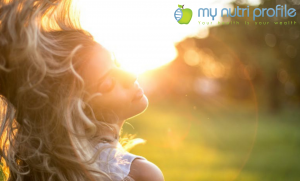
Soaking up the sun!

The topic of the benefits of sunlight versus its detrimental effects such as ageing and skin cancer is often debated. With messages such as “skin cancer on the increase” alongside those that too little sunlight is bad for your health, navigating how to spend time safely in the sun can feel confusing.
So firstly looking at the potential dangers, to clarify, it is the risks posed by heavy exposure to UV in sunlight that are the concern. UV is ultraviolet light, the blue end of the spectrum that can cause most damage to health. The charity Cancer Research UK ran a survey that reported that 75% of people asked were concerned about the hazard, but in reality less than one third seek shade and less than two fifths apply high factor sunscreen.
UV light causes the damaging effect of oxidation on the skin from the combination of light and heat. People who burn more easily have shown to be at a higher disposition to UV related cancers; as darker pigments protect the skin, those with fair or red hair whose skin burns easily are said to be 2 to 4 times more at risk than average. Those with white skin, but darker hair and eyes, who tan easily are at medium risk and at low risk are those with darker skin tones.
According to Dr James Inglis, public health consultant with the Health Education Board for Scotland “The risk of skin cancer is related to lifetime exposures to ultraviolet rays”. It is exposure over extended periods of time that is most readily apparent; the skin has a ‘memory’ for exposures and any detrimental changes such as burning or cosmetic and chemical use in toiletries can accumulate. This effectively causes the skin to thicken, which can make it less elastic and coarse, which is why sun exposure causes wrinkles and premature ageing. The National Health Department wants “outdoor workers to realise that a tan is not healthy but is a sign of damage to the skin. Constant exposure to the sun can put you at greater risk of skin cancer”.
But not all damage is as visible as burning or even a tan. UV radiation is not detectable as heat on the skin, so it is possible to not be aware of high exposure if there is a cooling breeze. UV rays split into UV-A and UV-B light, UV-B has always been seen to be more damaging as it is the part that causes sunburn and non-melanoma form of skin cancer. UV-A causes skin ageing and there is now a high level of concern that it increases the risk of malignant melanoma, the most dangerous form of skin cancer. UV-A has shown to cause DNA damage into cells deep within the skin at the layer where regeneration happens, which may increase a person’s chance of developing skin cancer.
The problem arises because sunscreens use sun protection factors (SPF) that are measured by timing how long skin covered with sunscreen takes to burn compared to uncovered skin. This translates that SPF 15 takes 15 times longer to burn than with no SPF and does not take UV-A rays into account, as they do not cause burning. The fear is that people believe they are protected when using sunscreens and so therefore take less precaution to stay in the shade and cover up with clothing, leaving them more exposed to UV-A damage. A study by scientists at Restoration of Appearance and Function Trust (RAFT) tested three high-factor sunscreens and found that they protected well against UV-B, but that the UV-A protection was “less than satisfactory”1. These findings have resulted in RAFT and other experts still advising to use sunscreen, but not to rely on it solely. Statistics show that people do not apply sunscreen often enough and then become complacent with other protection.
For full protection, the Cancer Research UK’s Sunsmart Campaign messages:
• Stay in the shade between 11am-3pm
• Make sure you never burn
• Always cover up with a t-shirt, wide-brimmed hat and sunglasses
• Take extra care with children
• Use at least factor 15 sunscreen and apply often
• Report any mole changes or unusual growths promptly to your GP
To protect people against the possibility of harm, sunlight has been touted as only damaging and its possible benefits often ignored. It is easy to understand this logic as many are not able to exercise moderation and it is natural for us to spend time outdoors in the sun. But there is also strong evidence that as we get less sunshine as a society, we are seeing more degenerative disease from lowered vitamin D levels.
Dr Michael F. Holick, a professor at Boston University’s medical school, was asked to resign his post in the dermatology department after criticism from the chairwoman of the department. He has written a new book called “The UV Advantage” and has been very outspoken about the importance of sun exposure in regulating vitamin D levels. Vitamin D is vital for bone health, immunity and mental health.
The American Academy of Dermatologists is calling Holick “irresponsible” as he recommends adequate sun exposure for health benefits. Holick has over 100 papers published, has developed treatments for psoriasis and studied the role of sunlight in vitamin D production and is hailed as “ahead of his time” by other dermatologists. Holick still says that sunburns increase the risk of skin cancer, but that moderate exposure can reduce the risk of prostate and breast cancers, based on population studies in warmer climates. He recommends just a few minutes of sun exposure on bare skin several times a week to help reduce vitamin D deficiency, hardly advocating the sun worshipping culture.
The naturally occurring form of vitamin D is called cholecalciferol or vitamin D3 and is actually a pre-hormone made on the skin by the action of sunlight and activated in the liver and kidneys. There is also new evidence that every organ in the body appears to produce a steroid hormone from vitamin D that is important for gene regulation2.
VDDS or Vitamin D Deficiency Syndrome is gathering evidence and categorised as a cluster of symptoms and signs associated with vitamin D deficiency, including osteoporosis, heart disease, high blood pressure, autoimmune diseases, certain cancers, depression and chronic fatigue or chronic pain. Vitamin D is used in many body functions such as calcium regulation and a deficiency can cause derangement of these functions.
For instance, there has long been an association between sunlight and elevated mood. This is now gathering scientific evidence that vitamin D has a significant biochemistry in the brain and psychiatrists are being advised to suspect the deficiency, especially in the aged, those who avoid the sun and those with darker skin.
Humans make at least 10,000 units of vitamin D within 30 minutes of full body exposure to the sun. Production in the skin occurs in minutes and is already maximised before skin turns pink. Fear of the fatal form of skin cancer, malignant melanoma keeps many out of the sun, despite the incidence increasing in many who have completely avoided the sun for years3. It is not that sunburns are ever safe, they are not, but whilst brief full body exposure to sunlight may slightly increase your risk of skin cancer the health risks of vitamin D deficiency may be worse. It is important to note that those with black skin need five to ten times longer in the sun than whites do to achieve similar vitamin D production.
The best form to supplement is cholecalciferol or vitamin D3 and we can derive some from food sources such as cold water fish (salmon, mackerel, trout, tuna, herring, sardines and anchovies), butter, egg yolks and dark green leafy vegetables. But it is debated how effectively the body can use ingested sources and sunlight is always the preferred method of supplementation. A good multivitamin usually contains about 100 iu (international units) of Vitamin D3, you can supplement more up to the British safety levels of 400 iu, especially if you have any of the symptoms above. This advice will apply more in winter, but for those who stay indoors or cover up during summer, it may still be worth asking for GP for a vitamin D test, especially if you also have immune, mental health or bone issues.
So what is the conclusion?
We would recommend that you heed the advice from the Sunsmart Campaign to avoid sunburn and dangerous UV-A exposure, but sensibly try to get some full body exposure several times a week for a maximum of 30 minutes to top up your vitamin D levels. Couple this with our advice for natural and dietary protection against harmful UV next week and you can feel the benefits of the sun without the dangers.
References:
1. Newcombe, R. BUPA Investigative News, 23 March 2004
2. Holick MF. The photobiology of vitamin D and its consequences for humans. Ann. NY Academy of Science. 1985; 453: 1-13
3. Hemminki K, Zhang H, Czene K. Incidence trends and familial risks in invasive and in situ cutaneous melanoma by sun-exposed body sites. Int. Journal of Cancer. 10 May 2003; 104(6): 764-71
Products:
Great organic and natural sunscreens without any of the nasties in more commercial brands:
- https://www.revital.co.uk/catalog/product/view/_ignore_category/1/id/120592/s/gpeople-org-sun-lotion-100ml-11441/
- https://www.revital.co.uk/catalog/product/view/_ignore_category/1/id/129148/s/alba-botanica-suncare-ffree-177ml-17395/
- https://www.revital.co.uk/sun-sun-spray-spf20-125ml
Natural after-sun products to help cool any heated effects:
- https://www.revital.co.uk/aloe-pura-aloe-vera-after-sun-lotion-200ml-1984
- https://www.revital.co.uk/green-people-aloe-vera-calendula-after-sun-200ml-11253
Vitamin D supplement spray:




